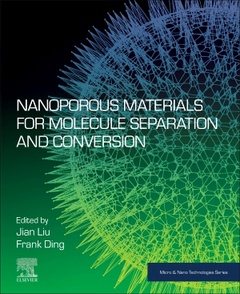Description
Nanoporous Materials for Molecule Separation and Conversion
Micro and Nano Technologies Series
Coordinators: Liu Jian, Ding Frank
Language: English
Subject for Nanoporous Materials for Molecule Separation and Conversion:
510 p. · 15x22.8 cm · Paperback
Description
/li>Contents
/li>Readership
/li>Biography
/li>Comment
/li>
Nanoporous Materials for Molecule Separation and Conversion cover the topic with sections on nanoporous material synthesis and characterization, nanoporous materials for molecule separation, and nanoporous materials for energy storage and renewable energy. Typical nanoporous materials including carbon, zeolite, silica and metal-organic frameworks and their applications in molecule separation and energy related applications are covered. In addition, the fundamentals of molecule adsorption and molecule transport in nanoporous materials are also included, providing readers with a stronger understanding of the principles and topics covered.
This is an important reference for anyone exploring nanoporous materials, including researchers and postgraduate students in materials science and chemical engineering. In addition, it is ideal for industry professionals working on a wide range of applications for nanoporous materials.
1 Synthesis and development of metal Shing Bo Peh and Dan Zhao 2 Nanoporous carbon materials: from char to sophisticated 3-D graphene-like structures Teresa J. Bandosz 3 Synthetic zeolites and their characterization Sebastian Prodinger and Miroslaw A. Derewinski 4 Nanoporous Silicas and their Composites T. Grant Glover, Brian J. Melde and Brandy J. Johnson 5 Fundamentals of gas separation in nanoporous materials Luisa Prasetyo, Shiliang (Johnathan) Tan, Hui Xu, Quang K. Loi, D.D. Do and D. Nicholson 6 Molecular transport in nanoporous materials Christian Chmelik and Jorg Karger 7 Hydrocarbon Molecules Separation using Nanoporous Materials Shane Lawson, Anirudh Krishnamurthy, Teresa Gelles, Harshul Thakkar, Ali A. Rownaghi and Fateme Rezaei 8 Carbon capture using nanoporous adsorbents Jian Liu 9 Contaminate removal with nanoporous carbon—modeling and simulation Frank Ding 10 Hydrogen and methane storage in nanoporous materials Joseph Winarta, Andra Yung and Bin Mu 11 Nanostructured materials for energy conversion and storage Katie Dongmei Li-Oakey 12 Nanoporous catalysts for biomass conversion Hui Shi, Karthikeyan K. Ramasamy, Ruoshi Ma and Huamin Wang 13 Nanoporous materials for proton exchange membrane fuel cell applications Sheng Sui, Huixin Zhang and Shangfeng Du
Researchers and postgraduate students of materials science, environmental chemistry, and chemical engineering; industry professionals working on applications of nanoporous materials
Frank Ding is a Research Specialist at 3M Company, USA. His research focuses on adsorption equilibrium, adsorptive air purifying technologies, simulation and modeling of fixed bed adsorption systems, cyclic regenerable gas separation, and air purifier service life calculation.
- Outlines the fundamental principles of nanoporous materials design
- Explores the application of nanoporous materials in important areas such as molecule separation and energy storage
- Gives real-life examples of how nanoporous materials are used in a variety of industry sector




